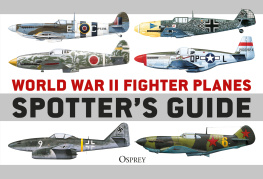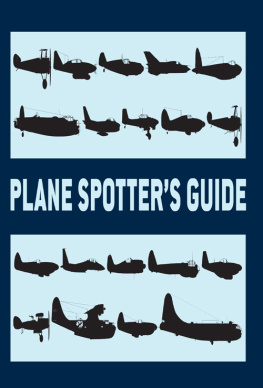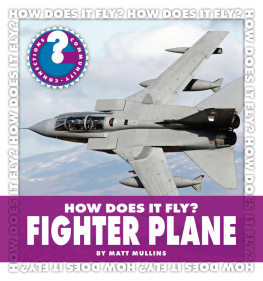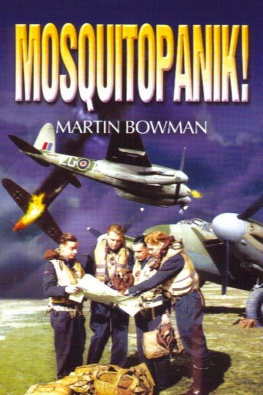Tony Holmes - World War II Fighter Planes Spotters Guide
Here you can read online Tony Holmes - World War II Fighter Planes Spotters Guide full text of the book (entire story) in english for free. Download pdf and epub, get meaning, cover and reviews about this ebook. year: 2020, publisher: Bloomsbury Publishing, genre: Non-fiction. Description of the work, (preface) as well as reviews are available. Best literature library LitArk.com created for fans of good reading and offers a wide selection of genres:
Romance novel
Science fiction
Adventure
Detective
Science
History
Home and family
Prose
Art
Politics
Computer
Non-fiction
Religion
Business
Children
Humor
Choose a favorite category and find really read worthwhile books. Enjoy immersion in the world of imagination, feel the emotions of the characters or learn something new for yourself, make an fascinating discovery.
- Book:World War II Fighter Planes Spotters Guide
- Author:
- Publisher:Bloomsbury Publishing
- Genre:
- Year:2020
- Rating:3 / 5
- Favourites:Add to favourites
- Your mark:
- 60
- 1
- 2
- 3
- 4
- 5
World War II Fighter Planes Spotters Guide: summary, description and annotation
We offer to read an annotation, description, summary or preface (depends on what the author of the book "World War II Fighter Planes Spotters Guide" wrote himself). If you haven't found the necessary information about the book — write in the comments, we will try to find it.
World War II Fighter Planes Spotters Guide — read online for free the complete book (whole text) full work
Below is the text of the book, divided by pages. System saving the place of the last page read, allows you to conveniently read the book "World War II Fighter Planes Spotters Guide" online for free, without having to search again every time where you left off. Put a bookmark, and you can go to the page where you finished reading at any time.
Font size:
Interval:
Bookmark:


OSPREY PUBLISHING
Bloomsbury Publishing Plc
PO Box 883, Oxford, OX1 9PL, UK
29 Earlsfort Terrace, Dublin 2, Ireland
1385 Broadway, 5th Floor, New York, NY 10018, USA
E-mail:
www.ospreypublishing.com
This electronic edition published in 2021 by Bloomsbury Publishing Plc
OSPREY is a trademark of Osprey Publishing Ltd
First published in Great Britain in 2021
Osprey Publishing Ltd, 2021
All rights reserved
You may not copy, distribute, transmit, reproduce or otherwise make available this publication (or any part of it) in any form, or by any means (including without limitation electronic, digital, optical, mechanical, photocopying, printing, recording or otherwise), without the prior written permission of the publisher. Any person who does any unauthorised act in relation to this publication may be liable to criminal prosecution and civil claims for damages.
A catalogue record for this book is available from the British Library.
ISBN: 978-1-4728-4851-2 (PB)
ISBN: 978-1-4728-4850-5 (eBook)
ISBN: 978-1-4728-4852-9 (ePDF)
ISBN: 978-1-4728-4853-6 (XML)
Front cover: All artwork copyright Osprey Publishing Ltd
Osprey Publishing supports the Woodland Trust, the UKs leading woodland conservation charity.
To find out more about our authors and books visit www.ospreypublishing.com. Here you will find our full range of publications, as well as exclusive online content, details of forthcoming events and the option to sign up for our newsletters. You can also sign up for Osprey membership, which entitles you to a discount on purchases made through the Osprey site and access to our extensive online image archive.
CONVERSION TABLE
| 1 millimetre (mm) | 0.0394in |
| 1 centimetre (cm) | 0.3937in |
| 1 metre (m) | 1.0936 yards |
| 1 kilometre (km) | 0.6214 miles |
| 1 kilogram (kg) | 2.2046 lb |
| 1 inch (in) | 2.54cm |
| 1 foot (ft) | 0.3048m |
| 1 yard | 0.9144m |
| 1 mile | 1.609km |
CONTENTS
AVIA B 534
SPECIFICATIONS (B 534-IV)
Crew: Pilot
Length: 26ft 7in (8.1m)
Wingspan: 30ft 10in (9.4m)
Height: 10ft 4in (3.15m)
Empty: 3,219lb (1,460kg)
Max T/O: 4,365lb (1,980kg)
Max speed: 252mph (405km/h)
Range: 370 miles (600km)
Powerplant: Hispano-Suiza 12Ydrs
Output: 849hp (633kW)
Armament: Four 7.92mm machine guns in fuselage; six 22lb (10kg) or four 44lb (20kg) bombs under wings
First Flight Date: 25 May 1933

B 534 (M-4) of catnik Jozef Stauder, No 13 Sqn, Tulczyn, Ukraine, summer 1941
Up until 1942, the B 534 was the standard equipment of Slovakian fighter units. This particular aircraft displays the Slovakian Air Arms (Slovenske vzdusne zbrane) camouflage scheme, with the wing uppersurfaces and fuselage sides in khaki overall, and the wing and fuselage undersurfaces in light blue. The aircraft also has the yellow markings displayed by all Axis aircraft on the Eastern Front. Jozo Stauder did not score any victories with the B 534, gaining all 12 of his kills in Bf 109s in 1943.
The B 534 biplane evolved from the limited-production B 34 of 1932 and became the most successful Czechoslovakian fighter design of the interwar period. Both aircraft were the work of Avias gifted aeronautical engineer Frantiek Novotn, who trialled several different engines in slightly modified B 34 airframes before settling on the license-built Hispano-Suiza 12Ydrs V12. The resulting single-bay biplane prototype completed its maiden flight on 25 May 1933, and the aircraft was ordered into series production for the Czechoslovak Air Force shortly thereafter. Despite its increasing obsolescence, the B 534 would be built by Avia through to 1939, by which time 568 aircraft had been completed in five variants.
The B 534-I, with guns mounted in the wings and on the fuselage, was the first to enter service in October 1935. The follow-on B 534-II had all four guns mounted in blisters on either side of the fuselage, and some examples also had a bubble canopy. The B 534-III of 1937 featured aerodynamic refinements, including mudguard spats for the fixed undercarriage and streamlining of the front carburettor air intake. The B 534-IV that quickly followed was the major production variant, with Avia completing 272 examples of the aircraft. It had various refinements that pushed the fighters top speed to 252mph. The final variant was the Bk 534, which was supposed to be fitted with a cannon firing through the propeller hub, but Avia had to stick with an extra machine gun due to installation issues with the weapon. Only 35 Bk 534s were built.
When Germany occupied Czechoslovakia in March 1939, more than 450 B/Bk 534s were commandeered by the Luftwaffe. The aircraft were briefly used as fighters and then trainers, and three frontline squadrons of the newly formed Slovak Air Force were also equipped with the aircraft. They would see action on the Eastern Front from June 1941. The Bulgarian Air Force also received 78 B 534-IVs from German stocks, and these aircraft tried to oppose the early USAAF bombing raids on the Ploesti oilfields. Finally, Greece and Yugoslavia had been export customers for the B 534 pre-war.
FIGHTER DETAILS

B 534 No 217 (S-18) of zastavnik Frantisek Cyprich, Combined Squadron (Kombinovana letka), Tri Duby, central Slovakia, AugustSeptember 1944
This aircraft was one of four obsolete B 534s operated by the insurgent Combined Squadron. It was flown by former members of No 13 Sqn, including Frantisek Cyprich, who had claimed 12 Soviet aircraft shot down. Flying a B 534 during the Slovak uprising against their former German allies, Fero Cyprich shot down a Hungarian Ju 52/3m transport the last ever kill to be scored by a biplane with a fixed undercarriage. This aircraft, which displays insurgent markings, has part of its canopy missing.
BELL P-39 AIRACOBRA
SPECIFICATIONS (P-39D/N)
Crew: Pilot
Length: 30ft 2in (9.19m)
Wingspan: 34ft 0in (10.36m)
Height: 11ft 10in (3.61m)
Empty: 5,645lb (2,560kg)
Max T/O: 8,300lb (3,765kg)
Max speed: 386mph (621km/h)
Range: 650 miles (1,046km)
Powerplant: Allison V-1710-85
Output: 1,200hp (895kW)
Armament: P-39D/N One 37mm cannon and two 0.50in machine guns in nose, two or four 0.30in machine guns in wings, one 500lb (227kg) bomb; P-39 Q two underwing 0.50in machine guns replaced wing-mounted 0.30in guns
First Flight Date: 6 April 1938 (XP-39)
Bells revolutionary P-39 introduced the concept of both the centrally mounted powerplant and the tricycle undercarriage to single-engined fighters, the aircrafts unusual configuration stemming from its principal armament, the propeller hub-mounted T9 37mm cannon. In order to allow the weapon to be housed in the nose, the P-39s engine was moved aft to sit virtually over the rear half of the wing centre-section. This drastically shifted the fighters centre of gravity, thus forcing designers to adopt a tricycle undercarriage. Unfortunately, the P-39s radical design was not matched by stunning performance figures, particularly at heights exceeding 14,000ft, where its normally aspirated Allison V-1710 struggled in the thinner air at these altitudes.
Font size:
Interval:
Bookmark:
Similar books «World War II Fighter Planes Spotters Guide»
Look at similar books to World War II Fighter Planes Spotters Guide. We have selected literature similar in name and meaning in the hope of providing readers with more options to find new, interesting, not yet read works.
Discussion, reviews of the book World War II Fighter Planes Spotters Guide and just readers' own opinions. Leave your comments, write what you think about the work, its meaning or the main characters. Specify what exactly you liked and what you didn't like, and why you think so.









